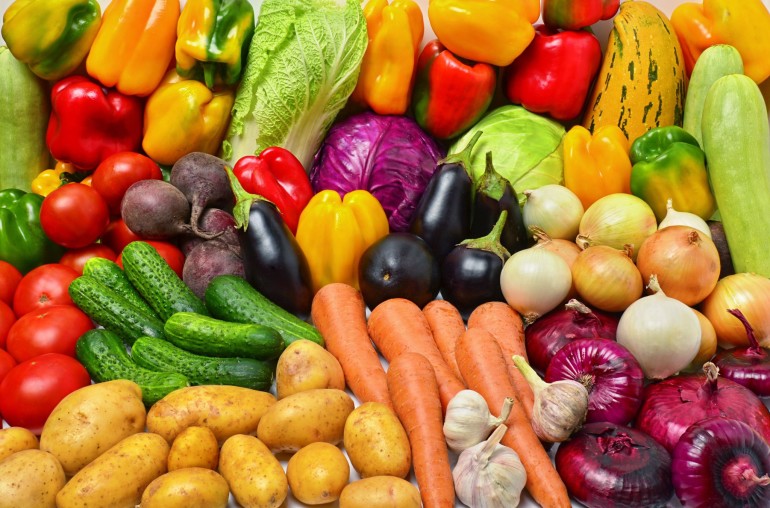
Photo by hbdjzds.com
PRODUCE IS DA BOMB
Vegetables totally rule and eating them is really nice. So you should do that.
Colors, textures, nutrients, and seasons all give these ground-foods just about the most variability you could ever want. On any given day in the Northeast you can have lettuces, tomatoes, squashes, beans, onions, beets and still feel like you could’ve explored other options. The “boring” food of childhood is anything but.
But aside from produce’s pleasures, there’s a pretty unique element of mindfulness. To eat produce is to have contact with the planet in a very direct way. You are literally eating the earth and with that comes a level of gratitude that feels really nice. (If you reduce me to a rambling Hippie, I likely don’t have far to look and point in your diet to show this, unless you’re a tyrannosaurus rex.)
Gettin’ the Goods
So, let’s say you’re down with the whole fresh produce thing. Now you have to go get some. It’s tempting to say “go to the store” and be done with it.
But living in Ithaca, NY, we find ourselves in a pretty unique situation. There are farms all over the place as well as solid networks that connect farmers to produce consumers. Wegmans, though super convenient and magical in the eyes of many, is not the only place to buy your fresh food.
Here, we’ll lay out a few options if you ever feel like exploring.
Wegmans
Of course, I can’t leave out Big Danny. There’s no denying that this is a solid option for produce. The store is pretty close to IC on Route 13, especially when you can get there on the TCAT bus. Prices are good, the selection is huge, you can do your other shopping at the same time, and for some reason, people treat this place like it’s more fun than an amusement park.
Convenience is the big asset here. You can walk around the Wegmans produce section and find all kinds of stuff. Prices will be pretty reasonable too – most things are a couple bucks per pound or per item, depending on how it’s sold.
Where’s this food coming from? Short answer: all over the place. I called a produce manager from the Ithaca Wegmans location and he told me their food comes mainly from Mexico, Chile, and across the U.S.. And these farms are large operations producing a bunch of stuff, so you can count on the use of pesticides, herbicides, and fertilizers to do so. The robust, bright quality of these veggies are a sign of these chemicals at play. Simply put, the produce is grown to last the long trip to the store and then sell once it gets there.
But Wegmans does have a slew of organic produce that grows on their own organic farms in Upstate New York. So, if you’re willing to spend a bit more, you can know where your food’s coming from and that it was grown without all those chemicals.

Photo by greenstar.coop
GreenStar
GreenStar is a cooperative market with two locations in town. One is on the corner of Buffalo and Meadow Streets, and the other is on Buffalo Street just off the commons.
What the heck is a cooperative? Basically, the store is owned and governed by regular community folks who all pay a membership fee for reduced prices and a say in operations.
Nearly all of the foods here are grown locally. Many nearby farms have contracts with GreenStar and are paid for regular shipments. So when you walk in you can expect a smaller building with produce that isn’t as “pretty – not always humungous, not always bright”. But this is one of GreenStar’s coolest aspects. There’s a comfort in having a solid idea of who and where your food comes from, and how it’s grown.
Another thing worth mentioning: you can make this option very affordable. GreenStar has a program that allows shoppers to work a minimum of 2 hours per week in exchange for a 17.5% discount at the checkout. It’s a common assumption that shopping locally is too expensive for college students, but there are ways to do it.

photo by ithacamarket.com
Farmer’s Market
Another option is the Ithaca Farmer’s Market located off Route 13 a little past Purity Ice Cream, heading towards the mall. This can also be accessed with the TCAT. Here, you can buy produce even more directly. You get to literally hand your money to the farmer and develop a relationship with the person that put the work into providing this food. There’s a real social element that feels so good to engage in.
CSA Farm Shares
This one’s my favorite. Similar to the Farmer’s Market, this option allows you to buy food directly from farmers and develop relationships. The difference is that here the relationship is ongoing.
CSA stands for Community Supported Agriculture. It’s a system where you pay a rate for a whole season’s worth of food and the farmer uses this money as their income. With multiple people paying for a membership, a farmer can make a living and everybody gets food.
Once you’ve paid your membership fee, each week the farmer sets a location where everybody gathers to pick up that week’s food. There’s a cool element of surprise because each week you get whatever is ready for harvest. Sometimes you’ll even get foods you’ve never seen before. But no worries, the farmer’s right there to tell you all about the food and how to use it.
Now Go Explore
It’s totally up to you which of these methods you enjoy most. But hopefully you’ll try a couple new ways before deciding. You might meet some new friends and find new foods along the way.



